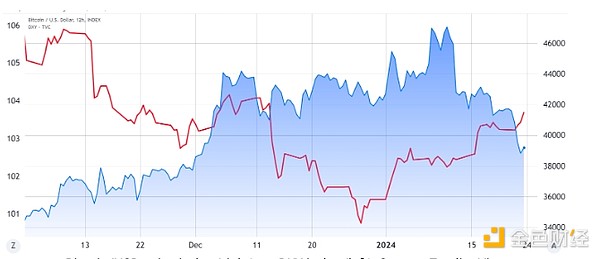Author: Marcel Pechman, Cointelegraph; Compiler: Songxue, Golden Finance
On January 23, the price of Bitcoin fell below $39,000 for the first time in more than 50 days. The decline began on January 11, coinciding with the U.S. Securities and Exchange Commission’s (SEC) approval of a spot Bitcoin ETF. The 17.5% correction in the 12 days to January 23 triggered liquidations in BTC long (buy) futures contracts totaling $385 million.
The U.S. economy now favors the stock market over Bitcoin
From a macroeconomic perspective, 2024 marks the return of the DXY index, which measures the dollar’s strength against a basket of foreign currencies, including the euro, pound and yen. After hitting 100.80 on December 28, 2023 (the lowest level in more than 5 months), the US dollar gained momentum and the index is currently hovering around 103.75. The move suggests investors believe the dollar's prospects remain favorable -- at least in relative terms -- despite fiscal problems.

Bitcoin/USD price index (right) and DXY index (left). Source: TradingView
Analysts and economists now have higher expectations for the Federal Reserve's successful strategy of curbing inflation without causing the economy to shrink. The one-year forecast for the U.S. economy fell to 2.43% in January 2024 from 3.09% in December 2023. Meanwhile, recession appears to be in the spotlight as The Conference Board's "Economic Forecast" predicts the U.S. economy will grow by 1.7%. U.S. GDP grew by 2.4% in the first quarter and 2.4% in the second quarter.
The odds of a rate cut in March fell to 47% from 81% the previous week, according to CME Group's FedWatch tool. Additionally, investors now expect only five rate cuts throughout 2024, compared with six previously expected. New York Fed President John Williams and Atlanta Fed President Raphael Bostic said they were in no rush to cut interest rates, if not a cut. According to CNBC, more rate hikes are on the table.
One might argue that the S&P 500 is currently near all-time highs; therefore, external factors affecting risk assets should also be favorable for Bitcoin. However, the drivers of the stock market are completely different from those of commodities, including cryptocurrencies. First, the 500 largest U.S. public companies have amassed a combined $2.6 trillion in cash positions, some of which generate dividends, so to some extent, the industry serves as a safe haven in the event of a mild recession.
Bitcoin price reflects spot ETF outflows and increased regulatory pressure
In addition to being viewed as a risk Assets aside,Bitcoin has faced its own problems, including net outflows from spot exchange-traded funds (ETFs) since January 17.
User Capital15C posted on the X social network that on January 22, the total number of Bitcoins held by U.S.-listed ETFs dropped to 645,054. While the $183 million outflow in 3 business days seems small in absolute terms, it contradicts investor expectations following the launch of the spot ETF.
Another concern for Bitcoin investors appears to be the bankruptcy estate of the now-defunct Mt. Gox exchange, which is expected to release approximately 142,000 Bitcoins. Some initial payments are due in December 2023, but the trustee expects to pay off creditors by October 2024. Finally,one should not ignore negative regulatory pressure, especially in the United States, which may not have direct implications for Bitcoin but may impact stablecoins.
On January 21, U.S. Senator Elizabeth Warren’s post cited a report claiming that “rogue states are using cryptocurrencies to evade sanctions and undermine our National Security". While the crypto community rushes to explain that “fiat is the currency of choice for financial crimes,” this happens to be true, but it does not diminish the potential negative consequences of regulatory actions and their subsequent impact on short-term prices.
 Kikyo
Kikyo






